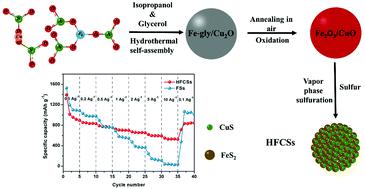当前位置:
X-MOL 学术
›
Inorg. Chem. Front.
›
论文详情
Our official English website, www.x-mol.net, welcomes your
feedback! (Note: you will need to create a separate account there.)
Constructing heterostructured FeS2/CuS nanospheres as high rate performance lithium ion battery anodes
Inorganic Chemistry Frontiers ( IF 6.1 ) Pub Date : 2020-03-09 , DOI: 10.1039/c9qi01674k Xiaoxia Xu 1, 2, 3 , Lingjie Li 1, 2, 3 , Huiqing Chen 1, 2, 3 , XiaoSong Guo 1, 2, 3 , Zhonghua Zhang 1, 2, 3 , Jing Liu 1, 2, 3 , Changming Mao 1, 2, 3 , Guicun Li 1, 2, 3
Inorganic Chemistry Frontiers ( IF 6.1 ) Pub Date : 2020-03-09 , DOI: 10.1039/c9qi01674k Xiaoxia Xu 1, 2, 3 , Lingjie Li 1, 2, 3 , Huiqing Chen 1, 2, 3 , XiaoSong Guo 1, 2, 3 , Zhonghua Zhang 1, 2, 3 , Jing Liu 1, 2, 3 , Changming Mao 1, 2, 3 , Guicun Li 1, 2, 3
Affiliation

|
Iron sulfides have been considered as a promising anode material in recent years, characterized by higher theoretical capacities, non-toxicity, and abundant reserves in nature. Nevertheless, they suffer from large volume changes during cycling and severe irreversible capacity loss because of their weak electronic conductivity as well as poor stability. In this work, heterostructured FeS2/CuS nanospheres (HFCSs) are successfully synthesized by a facile hydrothermal method and vapor phase vulcanization at mild temperature. The copper ions are uniformly distributed in the HFCS composites, endowing them with continuously high conductivity during the constant electrochemical process. When applied to lithium ion batteries, the composites exhibit impressive electrochemical performance. As expected, the assembled HFCS electrodes possess a high reversible capacity of 843.3 mA h g−1 even after 600 cycles at 1.0 A g−1 and a surprising rate capability of 530.4 mA h g−1 at 10.0 A g−1, which are superior to those of most of the reported FeS2 or CuS anode materials. The assembled HFCS electrodes possess both high conductivity and a porous structure, which is beneficial to the interior electron transport, reaction kinetics, lower volume changes and pulverization, significantly achieving improved rate capability as well as remarkable long-term cycling stability. This approach is feasible for fabricating heterogeneous porous structures and may shed some light on designing metal sulfide-based anode materials with high rate performance for energy storage applications.
中文翻译:

构建异质结构的FeS2 / CuS纳米球作为高性能锂离子电池阳极
近年来,硫化铁被认为是很有前途的阳极材料,其特征在于更高的理论容量,无毒且自然界中储量丰富。然而,由于它们的弱电导率以及较差的稳定性,它们在循环过程中遭受大的体积变化和严重的不可逆容量损失的困扰。在这项工作中,异质结构的FeS 2/ CuS纳米球(HFCSs)是通过简便的水热方法和温和的气相硫化成功合成的。铜离子均匀地分布在HFCS复合材料中,在恒定的电化学过程中使其具有连续的高导电性。当应用于锂离子电池时,复合材料表现出令人印象深刻的电化学性能。如所预期的,组装的HFCS电极具有843.3毫安Hg的高可逆容量-1在1.0克即使经过600次循环-1和530.4毫安Hg的令人惊讶的速率能力-1 10.0 A G -1,这是优于大多数报道的FeS 2的那些或CuS阳极材料。组装好的HFCS电极同时具有高电导率和多孔结构,这有利于内部电子传输,反应动力学,较低的体积变化和粉碎,从而显着提高了倍率能力以及出色的长期循环稳定性。这种方法对于制造异质多孔结构是可行的,并且可能为设计用于储能应用的具有高倍率性能的金属硫化物基阳极材料提供一些启示。
更新日期:2020-03-09
中文翻译:

构建异质结构的FeS2 / CuS纳米球作为高性能锂离子电池阳极
近年来,硫化铁被认为是很有前途的阳极材料,其特征在于更高的理论容量,无毒且自然界中储量丰富。然而,由于它们的弱电导率以及较差的稳定性,它们在循环过程中遭受大的体积变化和严重的不可逆容量损失的困扰。在这项工作中,异质结构的FeS 2/ CuS纳米球(HFCSs)是通过简便的水热方法和温和的气相硫化成功合成的。铜离子均匀地分布在HFCS复合材料中,在恒定的电化学过程中使其具有连续的高导电性。当应用于锂离子电池时,复合材料表现出令人印象深刻的电化学性能。如所预期的,组装的HFCS电极具有843.3毫安Hg的高可逆容量-1在1.0克即使经过600次循环-1和530.4毫安Hg的令人惊讶的速率能力-1 10.0 A G -1,这是优于大多数报道的FeS 2的那些或CuS阳极材料。组装好的HFCS电极同时具有高电导率和多孔结构,这有利于内部电子传输,反应动力学,较低的体积变化和粉碎,从而显着提高了倍率能力以及出色的长期循环稳定性。这种方法对于制造异质多孔结构是可行的,并且可能为设计用于储能应用的具有高倍率性能的金属硫化物基阳极材料提供一些启示。











































 京公网安备 11010802027423号
京公网安备 11010802027423号